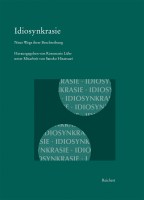Search
Editor: Lühr, Rosemarie
In cooperation with: Hisatsugi, Satoko
Idiosynkrasie
Neue Wege ihrer Beschreibung
2016
17.0 x 24.0 cm, 118 p., paperback / softback
ISBN: 9783954901821
17.0 x 24.0 cm, 118 p., paperback / softback
29,90 €
ISBN: 9783954901821
Short Description
Until now the concept of idiosyncrasy has been hardly associated with syntax or syntactic relations. Contributions of Indo-European linguistics show that it must be examined if there are indeed idiosyncratic syntactic phenomena. The data comes from Hittite, Vedic, Sanskrit, Greek, Latin, Venetic, Runic Norse, Welsh, Early New High German. Research questions are: Are idiosyncrasies in syntax actually irregularities or must they be explained by not stated rules? How do idiosyncrasies emerge historically? How are they being dealt with?Description
Until now the concept of idiosyncrasy has been hardly associated with syntax or syntactic relations. The following contributions of Indo-European linguistics show that it must be examined if there are indeed idiosyncratic syntactic phenomena. Under a broad concept of idiosyncrasy, hyphens in old inscriptions, null anaphora, the syntax of objects, the hyperbaton, idiosyncratic dass-clauses and idiosyncrasies in information structure are treated. The data comes from Hittite, Old Indic, Greek, Latin, Venetic, Runic Norse, Welsh, Early New High German. Research questions are: Are idiosyncrasies in syntax actually irregularities or must they be explained by not stated rules? How do idiosyncrasies emerge historically? How are they being dealt with?Syntagmatic relations on word level may be syntagmatic punctuations. In inscriptions of ancient languages hyphens work as representations of idiosyncrasies, if they cannot be explained from the existing systems. Evidence comes from Runic inscriptions in older Fuþark and Venetic inscriptions.
In old Indo-European languages the seemingly idiosyncratic structure in the distribution of null objects and clitica is due to verb semantics. In these languages verbs are oriented on aspect, whereby the event as a whole is at the center and less the participants. The pronoun is missing then not only because it is discoverable but because attention is focused on the verbal action.
In Welsh verbs formed analytically and synthetically are documented together with null elements. It is argued that the morphological behavior of finite verbs in context of either pronominal or non-pronominal and of either coordinated or non-coordinated subjects has to be attributed to the special functional development of weak subject pronouns.
The differences in the use of the hyperbaton in Old Indic and Hittite are substantial. While in Old Indic there are no restrictions on the hyperbaton, in Hittite this figure of speech is very rare. The hyperbaton is a highly idiosyncratic category because what belongs together is separated.
An apparent idiosyncrasy of sentence syntax is the conjunction dass as sentence-introductory element in German exclamatory sentences with verb-final order. Similar clauses under special pragmatic conditions, however, clearly indicate that dass is no idiosyncratic relic of earlier times.
Also information structural analyzes relating to the sentence topic contribute to the resolution of supposed idiosyncrasies. As Aboutness Topics frequently establish text coherence, namely by pronouns being marked as weak, it becomes comprehensible why just the second position is the preferred position in the sentence. A Topic in this position is thus no idiosyncrasy.
The treatment of all these issues is new in Indo-European linguistics.
Biographical Note
Rosemarie Lühr23.3.1946 geboren
1977 Promotion im Fach Vergleichende indogermanische Sprachwissenschaft mit den Nebenfächern Indoiranistik und Deutsche Philologie an der Universität Erlangen
1984 Habilitation im Fach Deutsche Philologie (Sprachwissenschaft) im Fachbereich Sprach- und Literaturwissenschaften der Universität Regensburg
Thema der Habilitationsschrift: Expressivität und Lautgesetz im Germanischen
1984-1990 Akademische Rätin an der Universität Regensburg
1990-1994 Universitätsprofessorin (C 4) für Vergleichende Sprachwissenschaft an der Justus-Liebig Universität Gießen
1994-2013 Universitätsprofessorin (C 4) für Indogermanistik an der Friedrich-Schiller-Universität Jena
Ordentliches Mitglied der Geisteswissenschaftlichen Klasse der Akademie gemeinnütziger Wissenschaften zu Erfurt
Ordentliches Mitglied der Philologisch-historischen Klasse der Sächsischen Akademie der Wissenschaften zu Leipzig
DFG-Gutachterin für Indogermanistik, im Fachkolleg Sprachwissenschaften: Typologie, Außereuropäische Sprachen, Ältere Sprachstufen, Historische Linguistik
seit Februar 2013 Honorarprofessorin an der Humboldt-Universität zu Berlin
Forschungsschwerpunkte: Syntax, Informationsstruktur, Etymologie, Grammatik altindogermanischer Sprachen




 Preface
Preface

 Neuerscheinungen 2023/2024
Neuerscheinungen 2023/2024
 Gesamtverzeichnis 2023/2024
Gesamtverzeichnis 2023/2024
 Katalog Oriental Studies & Linguistics
Katalog Oriental Studies & Linguistics
 Mittelalter
Mittelalter
 Deutsche Inschriften
Deutsche Inschriften
 Musiktherapie
Musiktherapie
 Literaturen im Kontext
Literaturen im Kontext